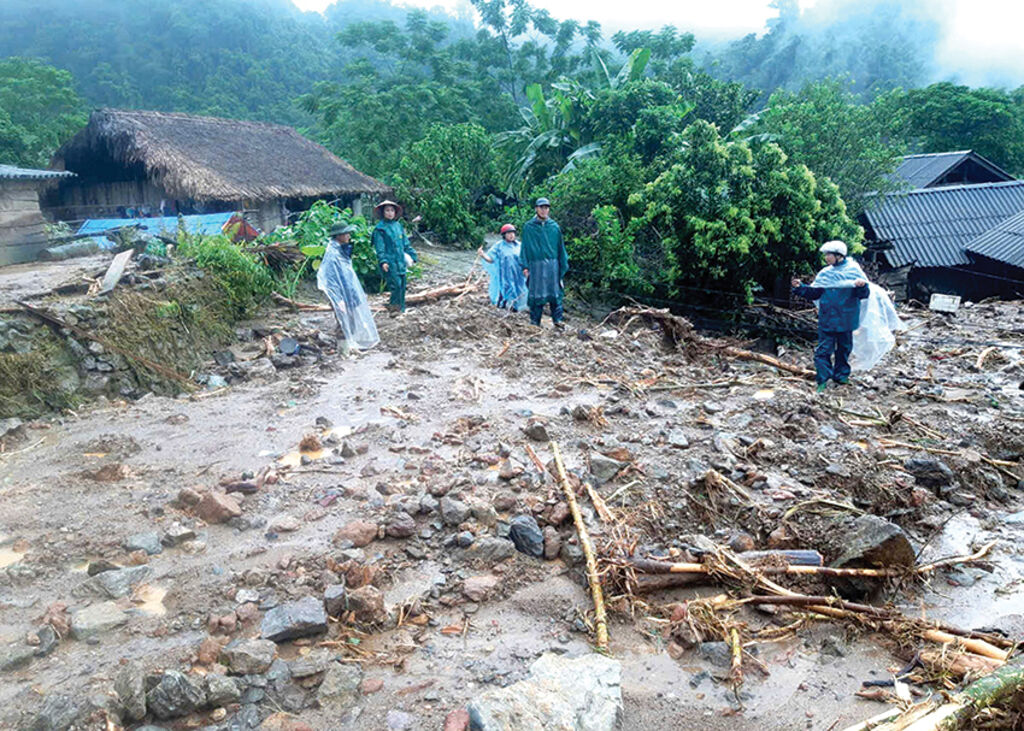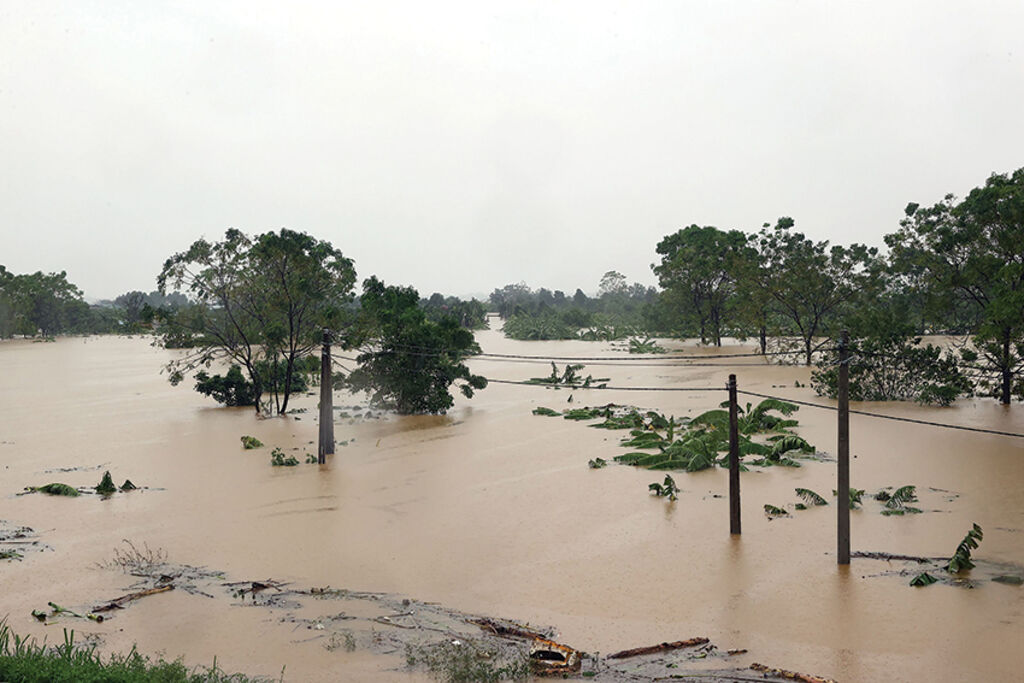 |
| Dong Tam village, Yen Thanh commune, Quang Binh district, Ha Giang province, suffers serious consequences caused by Typhoon Yagi and its circulation__Photo: VNA |
Agricultural insurance has long been recognized as a valuable business risk management tool that provides farmers with financial protection against production losses caused by unexpected events, especially disasters. However, despite the fact that Vietnam is one of top five countries most vulnerable to climate change, the coverage of agricultural insurance in the country is still too far below expectations.
In early September, Typhoon Yagi and its circulation have severely affected the country. According to statistics from the Ministry of Agriculture and Rural Development, more than 200,000 hectares of rice, 50,000 hectares of vegetable crops, and 60,000 hectares of fruit trees were damaged; nearly 4,000 aquaculture cages were ruined or swept away, and more than 26,000 livestock and nearly 3 million poultry were killed. The total damage caused by the typhoon to the agriculture sector is estimated at over VND 50 trillion (USD 2.1 billion).
After the typhoon swept away, Nguyen Van Dat, a farmer in Hai Duong province, found himself heavily indebted as his family’s two hectares of crops and four hectares of fruit trees were heavily damaged. Dat had poured an amount of about VND 600 million in the farms and most of the capital was borrowed from banks.
“I never thought something like this could happen,” Dat told the VietNamNet, admitting that he had neither considered agricultural insurance nor heard anyone talking about it.
For the time being, there are just four or five insurance companies providing agricultural insurance products in Vietnam, including Agribank Insurance (ABIC), Bao Viet Insurance, and Bao Minh Insurance. However, even ABIC, with 95 percent of its customer base made up of farmers, expects to pay out only VND 150 billion in compensation for losses caused by Yagi, a tiny figure that reflects the low participation rate in agricultural insurance among farmers.
 |
| Fruit trees and livestock farms in Tho Xuan commune, Dan Phuong district, Hanoi, are deeply submerged due to the Red River’s water level rise following Typhoon Yagi__Photo: VNA |
Why are both insurance companies and farmers not interested in agricultural insurance?
Agricultural insurance was launched for the first time in Vietnam more than a decade ago. In 2011, the Prime Minister issued Decision 315/QD-TTg on the pilot implementation of agricultural insurance in the 2011-13 period in 20 provinces and cities. Under the Decision, the State provided farmers with financial support for them to participate in agricultural insurance at the levels ranging from 20 percent to 100 percent of payable insurance premium amounts, depending on whether they were classified as poor, near-poor or ordinary households. In 2018, the Government promulgated Decree 58/2018/ND-CP, under which the support level varied from 20 percent to 90 percent of payable insurance premium amounts. Later in 2022, the Prime Minister signed Decision 13/2022/QD-TTg guiding the implementation of the policy on provision of support for farmers to participate in agricultural insurance under Decree 58.
However, both Decision 315 and Decree 58 restricted the scope of insured objects eligible for the State’s support to certain types of crop and livestock. Under Decision 315, the insured objects were rice; buffalo, cow, pig and poultry; and pawn, white-leg shrimp, Sutchi catfish and Bocourti catfish. Decree 58 extended such list, adding, on the one hand, rubber, pepper, cashew nut, coffee, fruit trees, and vegetables but, on the other hand, excluding Bocourti catfish.
“The Government really encourages the development of agricultural insurance,” said Ngo Trung Dung, Vice President of the Insurance Association of Vietnam(IAV). “However, most farmers don’t think about insurance until a disaster strikes, when it’s already too late,” he commented.
Assoc. Prof. Dr. Nguyen Van Dinh, former Dean of the National Economics University’s Insurance Department, identified four main reasons behind the stagnant situation of agricultural insurance in Vietnam: limited public awareness, lack of interest from insurance companies due to low premiums, challenges in risk management, and small scale of agricultural production. He also added that it is the moral hazard that makes insurance firms hesitate about providing agricultural insurance products to the market.
Agreeing with Dinh, IAV Vice President Dung admitted that the challenge lies in managing risks. “Insurance companies cannot measure the quantity of shrimp and fish in the pond, they just know what their customers declare,” he said.
From the perspective of farmers, because agriculture is a high-risk business, agricultural insurance premiums are often higher than those of other insurance products and seem unaffordable to farmers, even when they are eligible for the State’s support. It is not to mention the fact that most of farmers have yet to fully understand the significance of agricultural insurance, thus tending to regret the money to be spent on, rather than thinking about the benefits of, insurance when risks come.
Should agricultural insurance be made mandatory for all agricultural loan beneficiaries?
Although Decree 58 has emphasized the supportive role of insurance firms and banks for customers taking bank loans for agricultural production, in reality, banks just offer customers the choice of buying insurance for their loans so that in the event of misfortune, insurance firms will support customers to repay their loans. Moreover, under current regulations on lending activities of credit institutions and foreign bank branches in Vietnam, the decision whether to enter into loan insurance contracts will be agreed upon by banks and their customers on a voluntary basis.
An anonymous banking expert, in a talk with the VietNamNet, admitted that banks and their insurance partners are reluctant to provide insurance for crops and livestock due to risks associated with these objects.
The expert went on to suggest that the State should adopt policies to encourage and, if necessary, require enterprises and people to buy agricultural insurance when taking bank loans for investment in agricultural production.
“Banks should be required to offer preferential interest rates for businesses and farmer households that buy agricultural insurance when borrowing capital for crop or livestock production. In addition, agricultural insurance should be made mandatory for all agricultural loan beneficiaries,” the expert recommended.- (VLLF)









